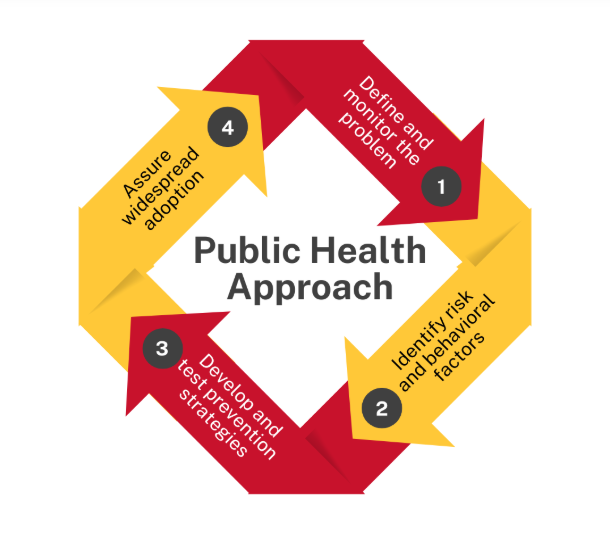The four-step public health approach
Goal
Prevent problems before they occur, using a systematic, evidence-based process that can scale from local to national levels.
This structured method, used by the CDC and leaders in public health like Johns Hopkins, mirrors how we’ve reduced traffic fatalities (through seatbelts, speed limits, and safer vehicles) and how we’re tackling violence today—particularly gun violence.
think of it as a cycle
Define Analyze Act Implement and scale
Source: Gun Violence as a Public Health Issue. Maryland.gov.
Step 1: Define and monitor the problem
- Collect and analyze data to clearly define the scope and nature of the problem.
- Establish a baseline for tracking trends and evaluating change.
- Use hospital records, death certificates, EMS data, and law enforcement databases to track shootings, homicides, and suicides.
- Map trends by age, race, geography, and setting (home, school, street).
- Injury surveillance systems.
- CDC’s WISQARS (Web-based Injury Statistics Query and Reporting System).
- National Violent Death Reporting System (NVDRS).
Source: CDC Violence Prevention: Step 1.
Step 2: Identify risk and protective factors
- Study why the problem is occurring:
- Who is most at risk?
- What conditions make them vulnerable?
- Identify protective factors that reduce likelihood or severity.
- Risk factors:
- Access to firearms.
- History of violence.
- Substance use.
- Poverty.
- Childhood trauma.
- Protective factors:
- Strong family relationships.
- Economic stability.
- Community cohesion.
- Mental health access.
- The goal: Intervene early, before harm occurs.
Step 3: Develop and test prevention strategies
- Use the data and research to design evidence-informed interventions.
- Pilot programs and evaluate their impact on behavior or outcomes.
- Intervention:
- Mandating seatbelts.
- Installing airbags.
- Creating DUI laws.
- Evaluation: Compare crash injury/death rates pre- and post-policy.
- Community violence interruption programs (e.g., Cure violence).
- School-based mental health initiatives.
- Extreme Risk Protection Orders (red flag laws).
Step 4: Assure widespread adoption
- Translate successful pilot strategies into broad practice and policy.
- Engage communities, train providers, and build infrastructure to support long-term change.
- Laws passed in all 50 states, tied to federal transportation funding .
- Mass public health campaigns (“Click It or Ticket”).
- Engineering and industry adoption in vehicle design.
- Public education about safe storage.
- Healthcare systems screening for firearm access in patients at risk.
- Statewide implementation of background checks and red flag laws.
Source: CDC injury and violence prevention.
The power of the public health model: Transferable to other issues
This approach has been used not only for traffic and violence prevention, but also for:
- Tobacco control (e.g., smoke-free laws, plain packaging).
- HIV prevention (e.g., needle exchanges, PrEP).
- Opioid crisis (e.g., naloxone distribution, PDMPs).
- Obesity and chronic disease (e.g., soda taxes, community gardens).



